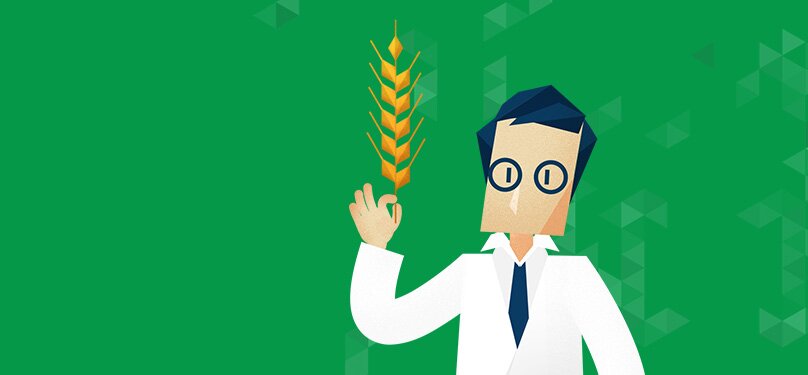The Seeds of a COVID-19 Response

23 September 2020
There’s been a lot of discussion during these past extraordinary months about the effect of the pandemic on the global food system. Such discussions often end in exhortations that “we mustn’t let the health crisis become a nutrition crisis,” and that “we must build back better.”
At first, the discussion mainly focused on the end of the food chain closest to the urban consumer. The crucial roles played by, for example, vegetable-picking migrants, the staff of meatpacking plants, transport workers and supermarket employees came into the spotlight as never before, and rightly so. As the pandemic progressed, attention was increasingly directed toward its effects on the nutrition of poor and marginalized groups.
What’s been less talked about is the other end of the food chain.
How has COVID-19 affected those who, in fields and in labs all over the world, conserve, manage, use and exchange the crop diversity on which the whole food system is built, and ultimately depends?
A webinar organized by the International Treaty on Plant Genetic Resources for Food and Agriculture (the Plant Treaty) and the Global Crop Diversity Trust (the Crop Trust) on 15 September, and sponsored by the Kingdom of Morocco, explored this question. The webinar brought together an international panel of experts representing local farmers’ organizations, national, regional and international genebanks, and both the formal and informal seed sectors. The results of a survey of 41 national programs carried out by the Plant Treaty were also presented.
So, how is crop diversity doing in the pandemic?
Not as bad as might be feared, actually, though it could use some help.
Start with farmers. It’s difficult to be sure what’s happening across all the world’s 500-odd million farms, of course, but according to the Plant Treaty’s survey, some farmer groups in Africa are already experiencing challenges in continuing to cultivate some key crops. Sergio Alonso from ASOCUCH (Asociación de Organizaciones de los Cuchumatanes), a farmers’ association, gave us a revealing glimpse of the situation on smallholder farms in Guatemala. Access to markets has collapsed, harvest losses have increased and opportunities for exchanging seeds among communities have been curtailed. But farmers have been able to harvest and save seeds, so at least no diversity has been lost.
At least not yet. As Shawn Mcguire of FAO reminded us, farmers obtain seeds from multiple sources—each other, markets and occasionally the government and relief agencies—and they are used to shocks. But with less money in their pockets and no way to travel, they will find it increasingly difficult to source seeds as the pandemic progresses. This may eventually lead to changes in crop profiles on farms: you sow what seeds you can get. Among other things, Mcguire called for efforts to diversify market outlets and bring them closer to smallholders, as well as for the roll-out of voucher schemes for seeds.
Anke van den Hurk of the International Seed Federation (ISF) showed how breeding companies—big, medium and small—have had to adapt in order to continue serving their customers, including smallholder farmers. She cautioned against the knee-jerk response of distributing free seeds to farmers, although Bert Visser made the point that access to seeds is already being affected in some of the places where Oxfam-Novib projects are active, and farmers will eventually need a helping hand. There was a suggestion that contracting Parties to the Plant Treaty be called upon to shore up informal seed systems where they are coming under serious pressure. What was clear from these complementary interventions is that there are great opportunities for stronger collaboration between the formal and informal sectors to ensure that, as the pandemic runs its course, farmers continue to have access to the diverse, quality seeds they need.
Sophia Gnych of the OECD said that transport restrictions and fewer staff were the main challenges facing the private seed sector, although Jonathan Shoham of IHS Markit painted a fairly rosy picture of the market situation, saying that seed sales have been stable for the four big companies. It seems the sector has been fairly resilient, at least in part due to flexibility and adaptability. As for the public sector, 75% of respondents to the Plant Treaty survey indicated that there had been a low or medium impact on research and breeding programs at the national level.
We also heard about what’s happening in genebanks: in India, in the Nordic countries and in CGIAR centers. If diversity disappears from farmers’ fields due to COVID-19, it might be possible to get it back from genebanks. But how are they coping?
Here again, the picture is one of flexibility and resilience. Some 80% of survey respondents indicated that there had been a negative effect on the work of genebanks, but in no case was this effect high. Diversity is not being lost. Genebank staff have had to learn a new way of working, and have reacted with great creativity, determination and commitment. However, field collecting activities have been impossible in India, we heard from Kuldeep Singh of the National Bureau of Plant Genetic Resources (NBPGR), and germplasm distribution has been curtailed. In many national genebanks, regeneration has had to be postponed or curtailed.
As for the CGIAR center genebanks, all have had to cut back operations, but none has ceased operating entirely, and things are now picking up again. Field and in vitro collections have been a particular challenge, said Stefan Schmitz of the Crop Trust, highlighting once again the importance of a systematic global effort to safety-duplicate such collections in cryobanks. That point was also made by Noelle Anglin, manager of the genebank of the International Potato Center (CIP), who described the necessary practical measures put in place to ensure the integrity of the in vitro potato collection maintained by CIP in Lima, Peru. We heard from Lise Lykke Steffensen of NordGen about how both that regional genebank and the Svalbard Global Seed Vault are coping, but there is no Svalbard for potatoes and other clonal crops. Yet.
All in all, the panel—and the survey—painted a picture of remarkable resilience in the face of an extraordinary shock. But they also made clear that resilience has its limits. We may not have reached those limits yet, but the virus is still out there. If we are to build back better, once the immediate threat of the pandemic has passed, we’ll need to do it together. Then we’ll be ready for the next shock.
The opinions expressed here are those of the authors and do not necessarily reflect the opinions or views of the Crop Trust. The Crop Trust is committed to publishing a diversity of opinions on crop diversity conservation and use.

